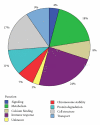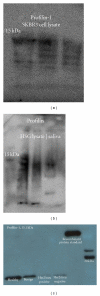Salivary Protein Profiles among HER2/neu-Receptor-Positive and -Negative Breast Cancer Patients: Support for Using Salivary Protein Profiles for Modeling Breast Cancer Progression
- PMID: 22570650
- PMCID: PMC3335259
- DOI: 10.1155/2012/413256
Salivary Protein Profiles among HER2/neu-Receptor-Positive and -Negative Breast Cancer Patients: Support for Using Salivary Protein Profiles for Modeling Breast Cancer Progression
Abstract
Purpose. The objective of this study was to compare the salivary protein profiles from individuals diagnosed with breast cancer that were either HER2/neu receptor positive or negative. Methods. Two pooled saliva specimens underwent proteomic analysis. One pooled specimen was from women diagnosed with stage IIa HER2/neu-receptor-positive breast cancer patients (n = 10) and the other was from women diagnosed with stage IIa HER2/neu-receptor-negative cancer patients (n = 10). The pooled samples were trypsinized and the peptides labeled with iTRAQ reagent. Specimens were analyzed using an LC-MS/MS mass spectrometer. Results. The results yielded approximately 71 differentially expressed proteins in the saliva specimens. There were 34 upregulated proteins and 37 downregulated proteins.
Figures





Similar articles
-
A Comparison of the Proteomic Expression in Pooled Saliva Specimens from Individuals Diagnosed with Ductal Carcinoma of the Breast with and without Lymph Node Involvement.J Oncol. 2009;2009:737619. doi: 10.1155/2009/737619. Epub 2009 Dec 20. J Oncol. 2009. PMID: 20052393 Free PMC article.
-
Breast cancer related proteins are present in saliva and are modulated secondary to ductal carcinoma in situ of the breast.Cancer Invest. 2008 Mar;26(2):159-67. doi: 10.1080/07357900701783883. Cancer Invest. 2008. PMID: 18259946
-
Differential gene expression patterns in HER2/neu-positive and -negative breast cancer cell lines and tissues.Am J Pathol. 2002 Oct;161(4):1171-85. doi: 10.1016/S0002-9440(10)64394-5. Am J Pathol. 2002. PMID: 12368191 Free PMC article.
-
Monitoring the circulating levels of the HER2/neu oncoprotein in breast cancer.Clin Breast Cancer. 2004 Jun;5(2):105-16. doi: 10.3816/cbc.2004.n.014. Clin Breast Cancer. 2004. PMID: 15245613 Review.
-
HER2/neu antisense targeting of human breast carcinoma.Oncogene. 2000 Dec 11;19(53):6138-43. doi: 10.1038/sj.onc.1204001. Oncogene. 2000. PMID: 11156527 Review.
Cited by
-
The Advent of Salivary Breast Cancer Biomarker Detection Using Affinity Sensors.Sensors (Basel). 2019 May 23;19(10):2373. doi: 10.3390/s19102373. Sensors (Basel). 2019. PMID: 31126047 Free PMC article. Review.
-
Cancer Salivary Biomarkers for Tumours Distant to the Oral Cavity.Int J Mol Sci. 2016 Sep 12;17(9):1531. doi: 10.3390/ijms17091531. Int J Mol Sci. 2016. PMID: 27626410 Free PMC article. Review.
-
Proteomics-Based Identification of Dysregulated Proteins in Breast Cancer.Proteomes. 2022 Oct 21;10(4):35. doi: 10.3390/proteomes10040035. Proteomes. 2022. PMID: 36278695 Free PMC article. Review.
-
Ultralow Limit Detection of Soluble HER2 Biomarker in Serum with a Fiber-Optic Ball-Tip Resonator Assisted by a Tilted FBG.ACS Meas Sci Au. 2022 Mar 15;2(4):309-316. doi: 10.1021/acsmeasuresciau.2c00008. eCollection 2022 Aug 17. ACS Meas Sci Au. 2022. PMID: 36785571 Free PMC article.
-
How Does Breast Cancer Heterogeneity Determine Changes in Tumor Marker Levels in Saliva?Curr Issues Mol Biol. 2025 Mar 21;47(4):216. doi: 10.3390/cimb47040216. Curr Issues Mol Biol. 2025. PMID: 40699615 Free PMC article.
References
-
- Wolff AC, Hammond MEH, Schwartz JN, et al. American Society of Clinical Oncology/College of American Pathologists guideline recommendations for human epidermal growth factor receptor 2 testing in breast cancer. Journal of Clinical Oncology. 2007;25(1):118–145. - PubMed
-
- Hammond ME, Hayes DF, Wolff AC. Clinical Notice for American Society of Clinical Oncology-College of American Pathologists guideline recommendations on ER/PgR and HER2 testing in breast cancer. Journal of Clinical Oncology. 2011;29(15):p. e458. - PubMed
-
- Ross JS, Fletcher JA. The HER-2/neu oncogene in breast cancer: prognostic factor, predictive factor, and target for therapy. Stem Cells. 1998;16(6):413–428. - PubMed
-
- Koscielny S, Terrier P, Spielmann M, Delarue JC. Prognostic importance of low c-erbB2 expression in breast tumors. Journal of the National Cancer Institute. 1998;90(9):p. 712. - PubMed
-
- Huang WY, Newman B, Millikan RC, et al. Risk of breast cancer according to the status of HER-2/neu oncogene amplification. Cancer Epidemiology Biomarkers & Prevention. 2000;9(1):65–71. - PubMed
LinkOut - more resources
Full Text Sources
Other Literature Sources
Research Materials
Miscellaneous

